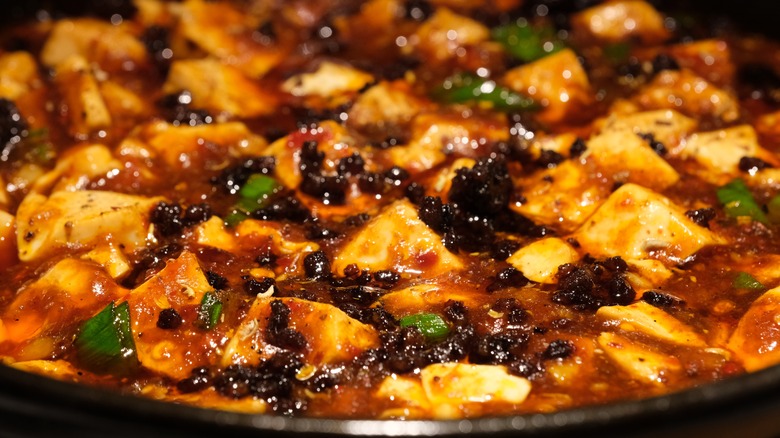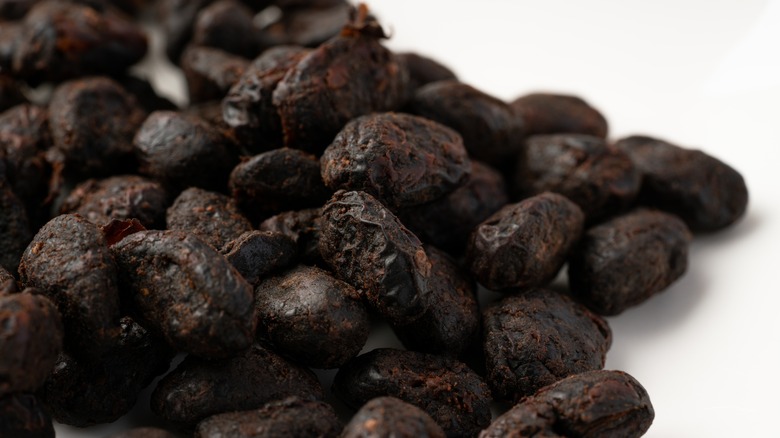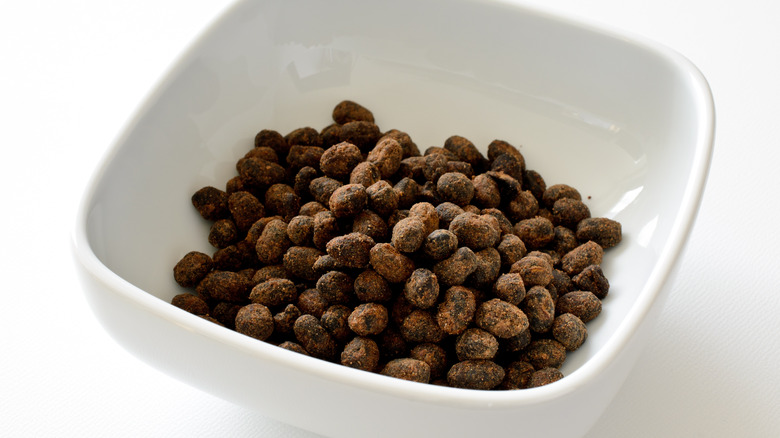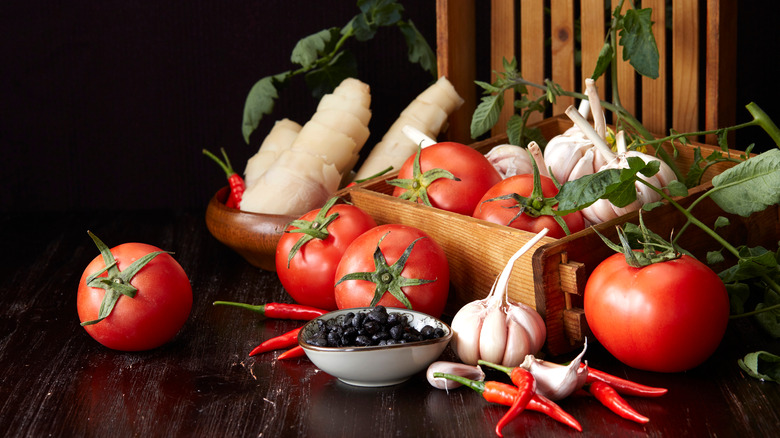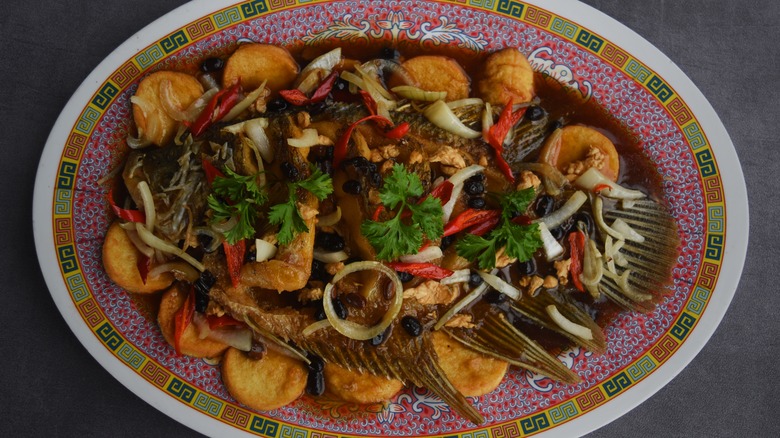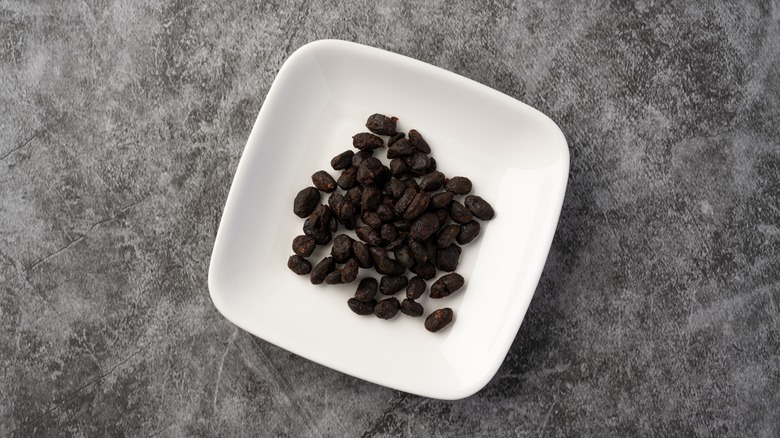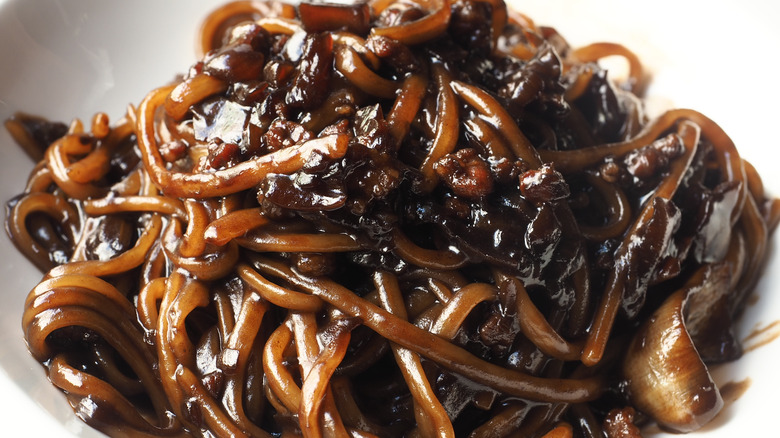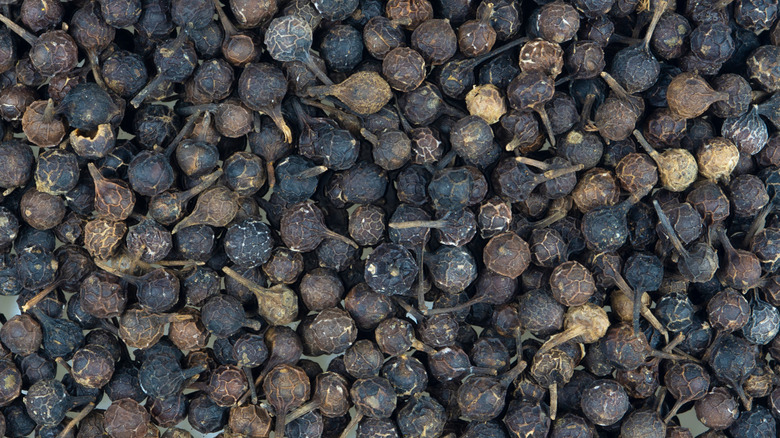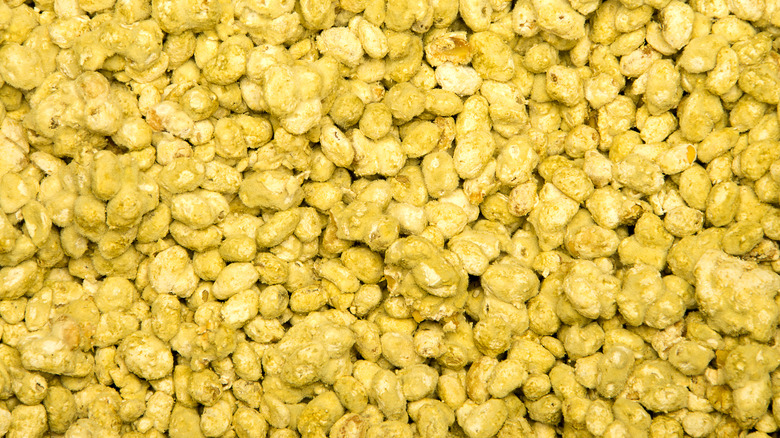Douchi, The Fermented Soybeans That Pack An Umami Punch In Any Dish
Of the handful of soybean products out there, many are fairly well known. Tofu, for one, is commonly used in popular dishes like miso soup and curry; edamame, the whole, immature form of the soybean, is often thrown into fried rice and stir-fries or sprinkled with salt and snacked on just as it is; tempeh is a fermented soybean ingredient that's a staple in Indonesian cuisine. However, none of these options are particularly like douchi, a wrinkly, black, fermented style of soybean from China that brings a punch of flavor to any dish you may add it to.
Though you may not want to eat this ingredient by itself, douchi is one of the easiest ways to amplify nearly any dish with a burst of umami. And while it's also not necessarily the easiest thing to find or make, its unique flavor makes it a classic addition to many pan-Asian dishes and a must-try if you're looking for an authentic way to enhance your Chinese culinary endeavors.
What is douchi?
Just like tempeh and miso paste, douchi is a fermented style of soybeans — usually black soybeans, which tend to have a nuttier, sweeter flavor than the yellow soybean-based ingredients you may be used to. The fermentation only enhances that while adding a salty and pungent aroma. But rather than blending the beans into a paste, as you'd do with miso, or fermenting them into a condensed cube, as is done with tempeh, the fermentation process of douchi produces dried, singular beans, which means they're used slightly differently than other soybean products.
Douchi is one of the oldest soy-based products in the world; archaeologists have found it in Chinese tombs that date back as far as 165 B.C. As a fermented form of the beans, douchi is an excellent way to enjoy black soybeans outside of the summer and fall months they're in season, which explains why, like many fermented foods, douchi has been a staple food for so long. In fact, the fresh black soybeans — or as they're known botanically, Glycine max — aren't nearly as popular or as common to come by because they tend to be more difficult to digest (per the Harvard School of Public Health).
How is douchi made?
Traditional douchi is made in two fermentation stages: First, the soybeans are soaked until they're soft, steamed until they're almost cooked, and left to ferment naturally for about 24 hours until they've developed small yellow hairs or spores. Then, once the spores are present, the beans are rinsed to remove the hairs (along with their associated bitter taste) and placed into jars with soy sauce and fermented soybean brine for another fermentation period. At this stage of the process, the douchi is much more watery, so once several months have passed, the beans are dried either in a drier or in the sun. Drying them not only gives them a denser texture but also turns them into an umami-rich ingredient; if the douchi is made using yellow soybeans, the drying process is also what transforms the beans' color to make them black.
If you're like most home cooks, however, you don't usually have the type of time that's necessary for the long fermentation process of making traditional douchi. Fortunately, there are simpler processes you can try at home that will give you a very similar flavor in less time, such as starting with a live soybean culture — and don't worry; if you can't get your hands on live fermented black soybeans at your local Asian store, you can use miso paste instead. Similarly, if you can't find black soybeans, you can use regular yellow ones (they'll turn out black in the end anyway).
What does douchi taste like?
While you may come across versions with additions like chili or five-spice powder, basic douchi contains just three ingredients: soybeans, the mold or starter, and salt. However, the extended multi-fermentation process that these simple ingredients undergo transforms them into a blend of pungent, aromatic, and umami flavors; like any other food, you shouldn't judge it solely on its ingredient list.
On its own, douchi may taste overbearingly salty. While it's always encouraged that you taste your ingredients before you use them, keep in mind that douchi is intended to be used as a condiment in dishes or mixed with other ingredients to create a sauce or paste — it's not generally eaten by itself.
Douchi's saltiness is actually its superpower. Just like parmesan cheese, it contains a natural form of MSG (monosodium glutamate), which is the cornerstone of the meaty, savory deliciousness that is umami — only douchi's is heightened with fermentation and time. In Chinese cooking, it's thought that saltiness rather than sweetness counters bitter flavors. For this reason, douchi is mixed with everything from soy sauce to sugar to vegetable oil to aromatics like garlic, ginger, and fresh chilies to create balance and add depth to a variety of dishes.
Cooking with douchi
As previously mentioned, douchi isn't meant to be enjoyed solo. Even though this funky-tasting soybean concoction is the foundation for dishes like mapo tofu, dou chi ji ding, and Cantonese steamed ribs, douchi prefers to share the limelight — it's primarily used as a flavoring agent in sauces and pastes or directly as a condiment to improve and boost the overall flavors of a dish. Generally, you'll want to utilize two tablespoons of douchi for every pound of food you're preparing, but how you work with it ultimately depends on what you're making.
For instance, if you're preparing a perfect stir fry using douchi, you should add the designated number of tablespoons of the beans into the wok with your cooking oil with any aromatics before adding your protein to the pan. On the other hand, when you're steaming with douchi, you'll want to add however much of it that you need directly to the protein before you start to steam it. In circumstances where you or someone you're cooking for might be watching their salt intake, you can rinse the douchi before cooking to tone down its saltiness. As for what flavors and proteins you pair the douchi with, there aren't any rules — it's all up to you and your imagination.
Where to buy douchi
Outside of China and East Asia, getting your hands on authentic, good-quality douchi can be difficult — and the same goes for the ingredients to make it yourself. But you may just be looking in the wrong places. Much like with tofu skin noodles, the odds of finding douchi (or the black soybeans to make it) at your everyday supermarket are slim unless yours has an impressively well-stocked Asian food aisle. But generally, you'll be better off visiting your local Chinese food store or Asian market, where you'll find bags of the fermented beans for around $3 to $4.
When you're shopping for douchi — which can sometimes also be found labeled in its Cantonese name, dau si — you'll find a few variations. For instance, there's natto, the Japanese fermented soybeans that are made with yellow soybeans and are a lot less salty. Then there are the Filipino, Vietnamese, and Cambodian dishes (taosi, tàu xì, and seang, respectively) similar to douchi that frequently contain seasonings that alter the taste. The best thing you can do is check the ingredient list for soybeans, mold or starter, and salt before purchasing.
While you can also find douchi online, shopping in person has some advantages. For one, you can check the packaging date to ensure that you get the freshest ones. If it's sold in jars, you can also investigate the size of the beans, how wrinkled they are, and whether they're sticking together for signs of freshness.
Douchi vs. Chinese black bean sauce
When you're shopping for douchi, you may also come across Chinese black bean sauce; in fact, they're often found near each other at the store. Judging from its name, you may assume that Chinese black bean sauce is the same as douchi or that they could at least be used interchangeably — they are both Chinese and made from black soybeans, after all. But that's not necessarily the case, and a quick look at the ingredient lists of each will explain why.
While douchi is made from three things — black or yellow soybeans, mold or fermentation starter, and salt — Chinese black bean sauce is a sauce made from douchi along with other additions like garlic and soy sauce. It's just one of the many sauces you can create using douchi, but it isn't an exact replacement and may not give you the results you hoped for if you try to use it as a replacement for douchi. Because of the added ingredients in black bean sauce, the fermented soy flavor won't come through as strongly as it does in pure douchi. While black bean sauce has its own delicious uses, it's best you leave it for your Chinese takeout and save the douchi for cooking classic Chinese dishes at home.
Douchi's nutritional information
Being a fermented food, it's no secret that douchi has some impressive health benefits, including improving gastrointestinal flora and digestion (per Healthline). Given the vital role your gut microbiome also plays in your immune, brain, and heart health (via Healthline), consuming douchi can have a positive impact on your overall health as well.
But because douchi is made from soybeans — the bean with the highest amount of protein per serving — it's also a significant source of plant-based protein. Even if you're not vegan or vegetarian, diversifying your diet with protein from plants is shown to be associated with increased longevity and reduced risk of chronic diseases (per UCLA Health). Douchi doesn't just deliver protein, however; thanks to the starter culture used to make douchi, it is also a source of powerful antioxidants that defend your body from free radicals. Not only that, but douchi also delivers important minerals, including calcium and iron.
Even with all of these benefits, however, douchi may not be for everyone. Anyone with a histamine intolerance or who is watching their sodium intake should be mindful of their douchi consumption, given that it contains high levels of both.
Other varieties of douchi
It's worth noting that beyond the different cultural adaptations of douchi found in countries outside of China, there are other varieties of douchi out there. For starters, you may come across something called "wet" or "watery" douchi when you're shopping. This douchi has only undergone the two stages of fermentation, up to the point where a mixture of soy sauce and fermented black beans are added to it — but the process stops there. And like the name suggests, "watery" douchi is just that: watery. It doesn't go through the drying stage that typical douchi does and therefore doesn't get that extra oomph of umami.
Besides watery douchi and dry, you'll also come across varieties that have been made using different types of starters. Some may begin from natural fermentation or from a starter mold culture that imparts Aspergillus oryzae — better known as koji — which is the same fungus used to make things like soy sauce, miso, and rice vinegar. Other douchi may include strains of starter mold such as Mucor racemosus or Rhizopus oligosporus. A study in Food Science and Human Wellness found a slight variation in flavor depending on the type of mold used, though this usually isn't significant enough to warrant calling the douchi something different. But if you buy pre-made douchi and notice you like the taste of one brand more than another, you might want to take note of the mold type listed on the label and choose another brand with the same starter type if your usual option isn't available.
